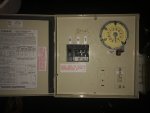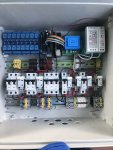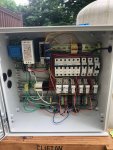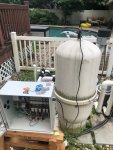- May 2, 2018
- 181
- Pool Size
- 20000
- Surface
- Plaster
- Chlorine
- Salt Water Generator
- SWG Type
- CircuPool Edge-40
EDIT 8/18/2019:
Node-RED flows now stored on github.
Youtube videos here: Hardware / Node-RED programming
---
Hi all. I wanted to share my new automation system with someone. My wife and kids don't really care but I think it's pretty neat.
Today all it does is the web interface, pump, lights, blower and scheduling of them. But the rest of the parts (actuators, ADCs for temp, pressure, and current readings) are on order.
It's powered by a raspberry pi and Node-Red which is really cool software that makes it easy to do stuff like this.
It replaced my load center so it's kind of big (16"x16"x8") but I was able to mount it on my existing post without too much trouble.
The picture is pre wiring. The wiring is ugly right now and I still have to re-run it to be prettier. Waiting on non-stranded copper so my bends will stay bent.
It uses an industrial style DIN rail to mount all the parts.
Features:
Scheduling and overrides (SPA/Pool mode and individual devices) from Web Interface
RS-485 adapter for integration with Intelli-series of pumps/chlorinators/etc. Node-red has a library for Pentair so this is fairly trivial to implement.
Power control:
16 relay board to drive mains power relays and actuators.
3 240v relays (Pump/Blower/TBD)
4 120v relays (SPA LED/Pool LED/Acid Pump/Chlorine Pump)
(All with supplementary circuit breakers)
1 Always on outside of box power outlet (120v) with weatherproof cover.
3 valve actuators (Pool/Spa intake/out valves and 1 to bypass filter when in spa mode, couldn't find a way to put an actuator on an MPV)
Raypak Heater control (basic dry contact relay)
Reporting/recording/alarming of:
Water/Air Temperature
Current Sensor for pump amp draw
Pressure of filter
To do:
pH testing (easy)
Chlorine testing (hard and/or expensive)




Node-RED flows now stored on github.
Youtube videos here: Hardware / Node-RED programming
---
Hi all. I wanted to share my new automation system with someone. My wife and kids don't really care but I think it's pretty neat.

Today all it does is the web interface, pump, lights, blower and scheduling of them. But the rest of the parts (actuators, ADCs for temp, pressure, and current readings) are on order.
It's powered by a raspberry pi and Node-Red which is really cool software that makes it easy to do stuff like this.
It replaced my load center so it's kind of big (16"x16"x8") but I was able to mount it on my existing post without too much trouble.
The picture is pre wiring. The wiring is ugly right now and I still have to re-run it to be prettier. Waiting on non-stranded copper so my bends will stay bent.
It uses an industrial style DIN rail to mount all the parts.
Features:
Scheduling and overrides (SPA/Pool mode and individual devices) from Web Interface
RS-485 adapter for integration with Intelli-series of pumps/chlorinators/etc. Node-red has a library for Pentair so this is fairly trivial to implement.
Power control:
16 relay board to drive mains power relays and actuators.
3 240v relays (Pump/Blower/TBD)
4 120v relays (SPA LED/Pool LED/Acid Pump/Chlorine Pump)
(All with supplementary circuit breakers)
1 Always on outside of box power outlet (120v) with weatherproof cover.
3 valve actuators (Pool/Spa intake/out valves and 1 to bypass filter when in spa mode, couldn't find a way to put an actuator on an MPV)
Raypak Heater control (basic dry contact relay)
Reporting/recording/alarming of:
Water/Air Temperature
Current Sensor for pump amp draw
Pressure of filter
To do:
pH testing (easy)
Chlorine testing (hard and/or expensive)




Last edited:




